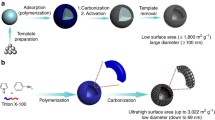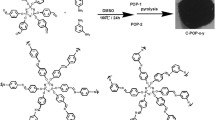Abstract
Design and synthesis of heteroatoms-doped porous carbon model materials with controllable nitrogen contents and similar pore structure are of great importance for fundamental understanding of the correlation between their intrinsic properties and applications. Herein, we report a synthetic strategy for synthesis of nitrogen-doped hollow carbon nanospheres with variable nitrogen contents, similar pore structure and morphology by pyrolysis of mixed polymer brushes formed through surface-initiated atom transfer radical polymerization of monomer mixtures of styrene and 4-vinylpyridine. With increasing 4-vinylpyridine fractions in the monomer mixture, nitrogen contents in the final carbon products increase up to about 5.5 wt%. As example applications, electrocatalytic performance for oxygen reduction reactions in both basic and acidic media and carbon dioxide adsorption properties of the thus-formed materials are investigated to evaluate the synthetic approach. The results reveal that the higher nitrogen contents doped in carbon do not guarantee the better performance for either electrocatalysis or carbon dioxide adsorption. It is the fraction of pyridinic nitrogen that dominates the electrocatalytic activity and carbon dioxide adsorption capacity. The findings demonstrate that mixed polymer brushes are promising precursors for the formation of heteroatoms-doped carbon materials, particularly as model materials for fundamental understanding their structure–properties correlations.







Similar content being viewed by others
References
Borup R, Meyers J, Pivovar B, Kim YS, Mukundan R, Garland N, Myers D, Wilson M, Garzon F, Wood D, Zelenay P, More K, Stroh K, Zawodzinski T, Boncella J, McGrath JE, Inaba M, Miyatake K, Hori M, Ota K, Ogumi Z, Miyata S, Nishikata S, Siroma Z, Uchimoto Y, Yasuda K, Kimijima K, Iwashita N (2007) Scientific aspects of polymer electrolyte fuel cell durability and degradation. Chem Rev 107:3904–3951
Bavarian M, Soroush M, Kevrekidis IG, Benziger JB (2010) Mathematical modeling, steady-state and dynamic behavior, and control of fuel cells: a review. Ind Eng Chem Res 49:7922–7950
Bae Y, Snurr RQ (2011) Development and evaluation of porous materials for carbon dioxide separation and capture. Angew Chem Int Ed 50:11586–11596
Abney CW, Taylor-Pashow KML, Russell SR, Chen Y, Samantaray R, Lockard JV, Lin W (2014) Topotactic transformations of metal–organic frameworks to highly porous and stable inorganic sorbents for efficient radionuclide sequestration. Chem Mater 26:5231–5243
Feng D, Lv Y, Wu Z, Dou Y, Han L, Sun Z, Xia Y, Zheng G, Zhao D (2011) Free-standing mesoporous carbon thin films with highly ordered pore architectures for nanodevices. J Am Chem Soc 133:15148–15156
Boakye FO, Fan M, Cai H, Zhang H (2018) Nitrogen-doped porous carbon derived from imidazole-functionalized polyhedral oligomeric silsesquioxane. J Mater Sci 53:456–465. https://doi.org/10.1007/s10853-017-1522-7
Ling Z, Wang Z, Zhang M, Yu C, Wang G, Dong Y, Liu S, Wang Y, Qiu J (2016) Sustainable synthesis and assembly of biomass-derived B/N co-doped carbon nanosheets with ultrahigh aspect ratio for high-performance supercapacitors. Adv Funct Mater 26:111–119
Rana M, Subramani K, Sathish M, Gautam UK (2017) Soya derived heteroatom doped carbon as a promising platform for oxygen reduction, supercapacitor and CO2 capture. Carbon 114:679–689
Guo D, Shibuya R, Akiba C, Saji S, Kondo T, Nakamura J (2016) Active sites of nitrogen-doped carbon materials for oxygen reduction reaction clarified using model catalysts. Science 351:361–365
Lv R, Cui T, Jun M, Zhang Q, Cao A, Su DS, Zhang Z, Yoon S, Miyawaki J, Mochida I, Kang F (2011) Open-ended, N-doped carbon nanotube–graphene hybrid nanostructures as high-performance catalyst support. Adv Funct Mater 21:999–1006
Niu W, Li Z, Marcus K, Zhou L, Li Y, Ye R, Liang K, Yang Y (2018) Surface-modified porous carbon nitride composites as highly efficient electrocatalyst for Zn-air batteries. Adv Energy Mater 8:1701642
Xing R, Zhou T, Zhou Y, Ma R, Liu Q, Luo J, Wang J (2018) Creation of triple hierarchical micro-meso-macroporous N-doped carbon shells with hollow cores toward the electrocatalytic oxygen reduction reaction. Nano-Micro Lett 10:20–33
Zheng F, Liu D, Xia G, Yang Y, Liu T, Wu M, Chen Q (2017) Biomass waste inspired nitrogen-doped porous carbon materials as high-performance anode for lithium-ion batteries. J Alloy Compd 693:1197–1204
Mao Z, Zhao S, Wang J, Zeng Y, Lu X, Tong Y (2018) Facile synthesis of nitrogen-doped porous carbon as robust electrode for supercapacitors. Mater Res Bull 101:140–145
Wu JH, Liu J, Li LG, Wang XF (2018) A bottom-up, template-free route to mesoporous N-doped carbons for efficient oxygen electroreduction. J Mater Sci 52:9794–9805. https://doi.org/10.1007/s10853-017-1165-8
Li Q, Shao Q, Wu Q, Duan Q, Li Y, Wang H (2018) In situ anchoring of metal nanoparticles in the N-doped carbon framework derived from conjugated microporous polymers towards an efficient oxygen reduction reaction. Catal Sci Technol 8(14):3572–3579
Guo J, Liu J, Dai H, Zhou R, Wang T, Zhang C, Ding S, Wang H (2017) Nitrogen doped carbon nanofiber derived from polypyrrole functionalized polyacrylonitrile for applications in lithium-ion batteries and oxygen reduction reaction. J Colloid Interface Sci 507:154–161
Li X, Sui Z, Sun Y, Xiao P, Wang X, Han B (2018) Polyaniline-derived hierarchically porous nitrogen-doped carbons as gas adsorbents for carbon dioxide uptake. Micropor Mesopor Mater 257:85–91
Kumar R, Joanni E, Singh RK, Singh DP, Moshkalev SA (2018) Recent advances in the synthesis and modification of carbon-based 2D materials for application in energy conversion and storage. Prog Energy Combust 67:115–157
Xu H, Ma L, Jin Z (2018) Nitrogen-doped graphene: synthesis, characterizations and energy applications. J Energy Chem 27:146–160
Ramakrishnan A, Dhamodharan R, Rühe J (2002) Controlled growth of PMMA brushes on silicon surfaces at room temperature. Macromol Rapid Commun 23:612–618
Saha S, Baker GL (2015) Substituent effects in surface-initiated ATRP of substituted styrene. Appl Surf Sci 359:911–916
Yu H, Luo Z (2011) Silica/polystyrene and silica/polystyrene-b-polymethacryloxy -propyltrimethoxysilane hybrid nanoparticles via surface-initiated ATRP and comparison of their wettabilities. Polym Eng Sci 51:218–224
Yin Y, Tian X, Jiang X, Wang H, Gao W (2016) Modification of cellulose nanocrystal via SI-ATRP of styrene and the mechanism of its reinforcement of polymethylmethacrylate. Carbohydr Polym 142:206–212
Jiang J, Zhang Y, Cao D, Jiang P (2013) Controlled immobilization of methyltrioxorhenium (VII) based on SI-ATRP of 4-vinyl pyridine from halloysite nanotubes for epoxidation of soybean oil. Chem Eng J 215–216:222–226
Wang R, Gao B, Jiao W (2009) A novel method for immobilization of Co tetraphenylporphyrins on P(4VP-co-St)/SiO2: efficient catalysts for aerobic oxidation of ethylbenzenes. Appl Surf Sci 255:4109–4113
Liang J, Du X, Gibson C, Du XW, Qiao SZ (2013) N-doped graphene natively grown on hierarchical ordered porous carbon for enhanced oxygen reduction. Adv Mater 25:6226–6231
Zhou T, Zhou Y, Ma R, Zhou Z, Liu G, Liu Q, Zhu Y, Wang J (2016) In situ formation of nitrogen-doped carbon nanoparticles on hollow carbon spheres as efficient oxygen reduction electrocatalysts. Nanoscale 8:18134–18142
Lai L, Potts JR, Zhan D, Wang L, Poh CK, Tang C, Gong H, Shen Z, Lin J, Ruoff RS (2012) Exploration of the active center structure of nitrogen-doped graphene-based catalysts for oxygen reduction reaction. Energy Environ Sci 5:7936–7942
Lin Z, Waller GH, Liu Y, Liu M, Wong C (2013) 3D Nitrogen-doped graphene prepared by pyrolysis of graphene oxide with polypyrrole for electrocatalysis of oxygen reduction reaction. Nano Energy 2:241–248
Shi XX, Zhang JN, Huang TL (2018) The key roles of trace iron for nitrogen, sulfur dual-doped carbon nanospheres as high efficient oxygen reduction catalyst. J Mater Sci 53:1404–1413. https://doi.org/10.1007/s10853-017-1605-5
Li X, Zhang F, Yuan J, Zhang H, Pan M, Huang C, Tang H (2016) Polyelectrolyte-brush-derived nitrogen-doped porous carbon. ChemNanoMat 2:1028–1032
Chen L, Zhang Y, Lin C, Yang W, Meng Y, Guo Y, Li M, Xiao D (2014) Hierarchically porous nitrogen-rich carbon derived from wheat straw as an ultra-high-rate anode for lithium ion batteries. J Mater Chem A 2:9684–9690
Kudin KN, Ozbas B, Schniepp HC, Prud’Homme RK, Aksay IA, Car R (2008) Raman spectra of graphite oxide and functionalized graphene sheets. Nano Lett 8:36–41
Shen W, Fan W (2013) Nitrogen-containing porous carbons: synthesis and application. J Mater Chem A 1:999–1013
Acknowledgements
This work was supported by the Natural Science Foundation of China under Grant numbers of 21576216 and 21878239, and International Cooperation and Exchanges Projects of Hubei Province (2017AHB057).
Author information
Authors and Affiliations
Corresponding authors
Ethics declarations
Conflict of interest
The authors declare that they have no conflict of interest.
Rights and permissions
About this article
Cite this article
Fan, M., Cheng, Y., Tu, W. et al. Fabrication of nitrogen-doped hollow carbon nanospheres with variable nitrogen contents using mixed polymer brushes as precursors. J Mater Sci 54, 8121–8132 (2019). https://doi.org/10.1007/s10853-019-03320-2
Received:
Accepted:
Published:
Issue Date:
DOI: https://doi.org/10.1007/s10853-019-03320-2




